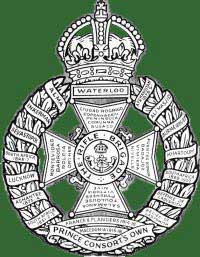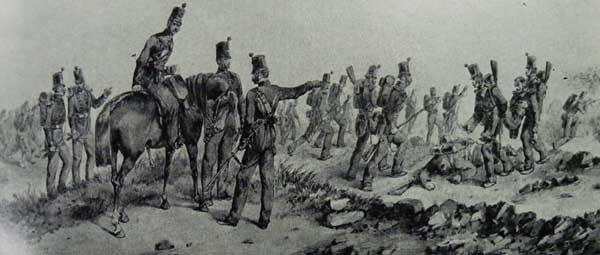The Rifle Brigade and the Crimean War
George Hunnisett spent part of his adult life serving in the 2nd Battalion of the Rifle Brigade and in 1854 saw action in the Crimean War. The following extract is from a book called 'The Rifle Brigade' by Basil Harvey, part of the Famous Regiments series.

Field-Marshal H.R.H. Albert, Prince Consort, succeeded the Duke [of Wellington] as Colonel-in-Chief on 23 September, 1852. On 6 June 1854, an order was issued that stated that in future the subalterns of the Regiment should be styled not Second-Lieutenent but Ensign, defined by Dr Johnson as ‘the officer of Foot who carries the flag’. Since neither the 95th nor the Rifle Brigade had ever had a flag to carry, this was patently absurd, but the anomaly persisted until 1872.
Both Battalions went to Bulgaria in September 1854, on the outbreak of the Crimean War. Supporting the cavalry and protecting the guns they were present at the action on the Bulganak on 19 September, when Col Sidney Beckwith was struck down by cholera of which he died on the 25th.
At the Battle of the Alma on 20 September, the 2nd Battalion led the way across the river, driving the Russians before them. Lord Raglan wrote in his Despatch, ‘The capture of the great redoubt was materially aided by the advance of four Companies of the Rifle Brigade under Major Norcott’, whom Sir George Brown recommended for the Victoria Cross, which, however, was not granted.
The Rout of the Russians was not followed up until the 23rd, when the 1st Battalion provided the rearguard of the Army. The 2nd headed the advance, and after a typical skirmishing manoeuvre, it occupied Balaclava before proceeding to Sevastopol, where both Battalions provided cover for the working parties of Engineers and Gunners digging trenches and gun emplacements. On 12 October Rifleman Francis Wheatley of the 1st Battalion won the Victoria Cross for throwing a live shell which had fallen among his party over a parapet after unsuccessfully trying to knock out the fuse with the butt of his rifle.
Constant vigilance was essential. When a Russian column approached to attack the five-gun battery, Major Fyers and his Company opened fire at 750 yards, charged and drove off the Russians, before supporting troops could reach them. From 16 October onwards, Riflemen were sent out every night in advance of both trenches and covering parties to form a double line of sentries. On the 17th the siege began. Although a party of Riflemen silenced six Russian guns at Balaclava, the Regiment was not heavily engaged.
When Gen. Cathcart, commanding the 4th Division, at whose head was the 1st Battalion, went to the assistance of the hard-pressed Gen. Pennefather on the heights of Inkerman, he said 'I have brought you a Battalion which can do anything'. Col Horsford split his Battalion. Major Rooper took the leading three Companies to the left, whilst he himself led three Companies to the right, where they fought their way round the Barrier and completed a pincer movement. During this terrible battle many of the Riflemen, true to their traditions, fought independently or in twos and threes, taking detonating caps from dead Russians' when their own were exhausted. Finally Horsford pushed up the Shell hill and, charging with fixed swords, the Rifles drove the Russians from the ridge.

The sufferings of the men were severe, caused by the terrible weather and lack of rations which were often unusable even if they did arrive. Coffee was green, there were no vegetables, biscuits were mouldy, fuel scanty and the state of clothing and boots deplorable. A great gale on 14 November blew away a number of tents which were never recovered. However, that of a wounded officer was held by his men, who, by sparing him exposure to the storm, saved his life.
Russian Riflemen had established themselves in rifle-pits or caves called by Riflemen ‘The Ovens', whence they inflicted great damage on British and French working parties. The French Commander, Gen. Canrobert, asked Lord Raglan to dislodge the enemy. Lt Henry Tryon, with Lts Bourchier and Cunninghame and two hundred men from the 1st Battalion took the Russians by surprise, and drove the enemy from their cover, supported though they were by a heavy column of Russian infantry. Guns bearing on the pits poured grape and canister on the Riflemen. Tryon was killed in the moment of capturing the pits, but Bourchier maintained his advantage, while Cunninghame repulsed an attempt to turn their flank. Sometimes with strong columns, sometime a few at a time, the Russians repeatedly tried during the long night, to retake the pits, but the Riflemen under their two young officers held the position until relieved next day by another party from the Battalion.
Bourchier and Cunninghame were awarded the VC, which Tryon was denied because it was not then awarded posthumously. On 2 December the Russians retook ‘The Ovens’ from another regiment. A party of the 1st Battalion quickly attacked the Russians, drove them out and retook possession of the trenches, which they held as the guard for the day. An NCO, asked how they came to be there, replied ‘If you please, sir, the Russians relieved the ?th, and we relieved the Russians.’
In the trenches before Sevastopol cholera and dysentery ravaged both Battalions. Driving snow persisted throughout January and February 1855; food was scanty. However, in March the weather improved, supplies became more adequate and suffering diminished. When on 22 April a popular Bandsman of the 2nd Battalion, Wright, was killed by Russian Snipers while fetching water, Riflemen Bradshaw, Humpston and MacGregor won their VCs for the gallantry with which under heavy fire they avenged his death, by driving the Russians from their rifle pits.
Both Battalions took part in the first attack on the Redan on 18 June, suffering heavy casualties, but it was not until 8 September that the Redan was captured, Sevastopol taken and its dockyards destroyed. For his gallantry at the Battle of the Alma, and later at the Redan, Lt John Knox was awarded the VC. Although fighting continued for some time, both Battalions were thereafter occupied in garrison duties until in June 1856 they embarked for England.
On 24 February, 1855, the 1st Battalion had received the long Enfield rifle in place of the Minie. It was during the Crimean War that the Rifle Depot was formed at Winchester, where it has remained. The old barracks were destroyed by fire in 1894 and not completely rebuilt until 1904, when the present buildings, modernized extensively in recent years, became the finest military installation in England.
The 2nd Battalion paraded in London on 26 June, 1856, for the first distribution by Queen Victoria of the Victoria Cross. Four officers and four riflemen received the Cross from the hands of Her Majesty.